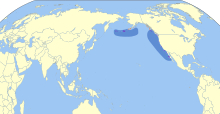Cassin's auklet
| Cassin's auklet | |
|---|---|

| |
| Scientific classification | |
| Domain: | Eukaryota |
| Kingdom: | Animalia |
| Phylum: | Chordata |
| Class: | Aves |
| Order: | Charadriiformes |
| Family: | Alcidae |
| Genus: | Ptychoramphus Brandt, JF, 1837 |
| Species: | P. aleuticus
|
| Binomial name | |
| Ptychoramphus aleuticus (Pallas, 1811)
| |

| |
Cassin's auklet (Ptychoramphus aleuticus) is a small, chunky
Cassin's auklet is a small (25 cm, 200 g) nondescript auk. Its plumage is generally dark above and pale below, with a small white mark above the eye. Its bill is overall dark with a pale spot, and its feet are blue. Unlike many other auks, Cassin's auklet lacks dramatic breeding plumage, remaining the same over most of the year. At sea it is usually identified by its flight, which is described as looking like a flying tennis ball.
Cassin's auklet ranges from midway up the Baja California peninsula to Alaska's Aleutian Islands, off North America. It nests on offshore islands, with the main population stronghold being Triangle Island off Vancouver Island's Cape Scott, where the population is estimated to be around 55,0000 pairs. It is not known to be migratory. However, northern birds may move farther south during the winter.
Two subspecies are recognised:[2]
- P. a. aleuticus – (Kurile Islands.
- P. a. australis – van Rossem, 1939: southern Baja California.
An extinct relative or predecessor species, Ptychoramphus tenuis L. H. Miller et Bowman, 1958, is known from the Late Pliocene of the San Diego Formation in California.
Behaviour
Cassin's auklet nests in burrows on small islands, and in the southern area of its range may be found in the breeding colony year round. It either digs holes in the soil or uses natural cracks and crevices to nest in, also readily using man-made structures. Pairs will show a strong loyalty towards each other and to a nesting site for many years. Both the parents
Most individuals in a cohort begin breeding at age 3 (27%), and by 8 years >95% of a given cohort has recruited.[3] Mean age of recruitment is 3.6 years.[3] Minimum annual breeding propensity is 0.83, apparent local survival is 0.76, juvenile survival (ages 0 to 2) is 0.15.[3]
At sea Cassin's auklets feeds offshore, in clear often
Conservation
Cassin's auklet is listed as Near Threatened,
2014 summer mass death in US
In the last few months of 2014, the carcasses of thousands of Cassin's auklets washed ashore from Northern California up to the north coast of Washington State.
References
- . Retrieved 11 November 2021.
- Rasmussen, Pamela, eds. (August 2022). "Noddies, gulls, terns, skimmers, skuas, auks". IOC World Bird List Version 12.2. International Ornithologists' Union. Retrieved 10 November 2022.
- ^ S2CID 85604692.
- .
- ^ CASSIN’S AUKLET Ptychoramphus aleuticus by the US Fish & Wildlife Service
- PMID 17302841.
- ^ Bird carcasses along Pacific shore baffle biologists, Los Angeles Times
- ^ a b "Mass Death of Seabirds in Western U.S. Is 'Unprecedented'". Archived from the original on January 26, 2015. Retrieved 25 January 2015.
- ^ "Unusual North Pacific warmth jostles marine food chain". Retrieved 25 January 2015.
Further reading
- Boyd, W. S.; MacFarlane Tranquilla, L.; Ryder, J. L.; Shisko, S. G.; Bertram, D. F. (2008). "Variation in marine distributions of Cassin's Auklets (Ptychoramhus aleuticus) breeding on Triangle Island, British Columbia". The Auk. 125: 158–166. S2CID 28906143.
- Manuwal, D. A. and A. C. Thoresen. 1993. Cassin's Auklet (Ptychoramphus aleuticus). In The Birds of North America, No. 50 (A. Poole and F. Gill, Eds.). Philadelphia: The Academy of Natural Sciences; Washington, D.C.: The American Ornithologists' Union.
External links
- Cassin's auklet images from tsuru-bird.net by Monte M. Taylor
- Cassin's auklet photo gallery by VIREO

